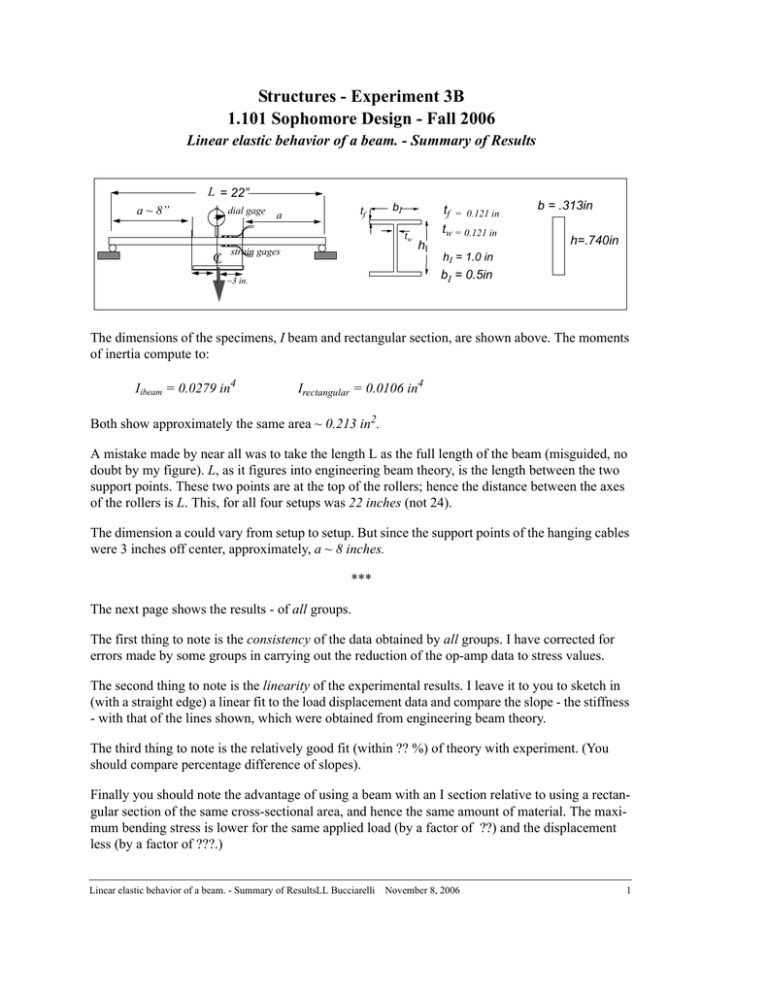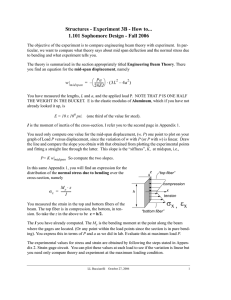Structures - Experiment 3B 1.101 Sophomore Design - Fall 2006
advertisement

Structures - Experiment 3B 1.101 Sophomore Design - Fall 2006 Linear elastic behavior of a beam. - Summary of Results L = 22” a ~ 8” dial gage tf a bI tw CL strain gages hI tf = 0.121 in tw = 0.121 in b = .313in h=.740in hI = 1.0 in bI = 0.5in ~3 in. The dimensions of the specimens, I beam and rectangular section, are shown above. The moments of inertia compute to: Iibeam = 0.0279 in4 Irectangular = 0.0106 in4 Both show approximately the same area ~ 0.213 in2. A mistake made by near all was to take the length L as the full length of the beam (misguided, no doubt by my figure). L, as it figures into engineering beam theory, is the length between the two support points. These two points are at the top of the rollers; hence the distance between the axes of the rollers is L. This, for all four setups was 22 inches (not 24). The dimension a could vary from setup to setup. But since the support points of the hanging cables were 3 inches off center, approximately, a ~ 8 inches. *** The next page shows the results - of all groups. The first thing to note is the consistency of the data obtained by all groups. I have corrected for errors made by some groups in carrying out the reduction of the op-amp data to stress values. The second thing to note is the linearity of the experimental results. I leave it to you to sketch in (with a straight edge) a linear fit to the load displacement data and compare the slope - the stiffness - with that of the lines shown, which were obtained from engineering beam theory. The third thing to note is the relatively good fit (within ?? %) of theory with experiment. (You should compare percentage difference of slopes). Finally you should note the advantage of using a beam with an I section relative to using a rectan gular section of the same cross-sectional area, and hence the same amount of material. The maxi mum bending stress is lower for the same applied load (by a factor of ??) and the displacement less (by a factor of ???.) Linear elastic behavior of a beam. - Summary of ResultsLL Bucciarelli November 8, 2006 1 50 I beam W - Total load - pounds 40 Rectangular 30 w midspan 2 2 Pa = – ⎛⎝ ------------⎞⎠ ⋅ ( 3L – 4a ) 24EI 20 P = W/2 10 0 Load versus Displacement 10 20 30 40 50 60 70 80 90 100 x10-3 Midspan displacement - inches 8 x 103 Stress versus Load Max. Normal Bending Stress - psi 7 Rectangular 6 h M y ⋅ ⎛ ---⎞ ⎝ 2⎠ σ x = --------------------I 5 4 3 I beam 2 1 0 10 20 30 40 50 W - Total load - pounds Linear elastic behavior of a beam. - Summary of ResultsLL Bucciarelli November 8, 2006 2





